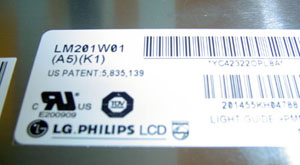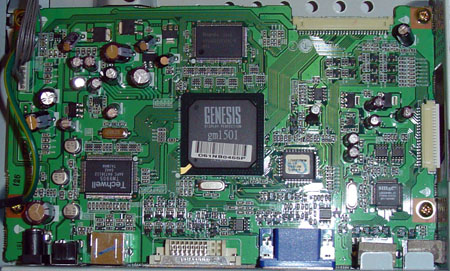The 20" LCD Shootout: Dell versus Apple
by Kristopher Kubicki on April 27, 2005 12:05 AM EST- Posted in
- Displays
Internals
After benchmarking both monitors, we opened them up to get a more in-depth look at the individual apparatuses. Doing this will certainly void your warranty, and most likely irrevocably damage an Apple Cinema display. The acrylic bezels on the sides of the Apple Cinema displays seem extremely fragile, and we actually put a hairline crack in our bezel during the course of the evaluation.The internals of our Apple Cinema 20” display reveal nothing particularly interesting. Since the Apple relies only on digital inputs, the digital signal processor (DSP) for our display is relatively small. The majority of the circuitry on the PCB inside the monitor is reserved for the USB and Firewire pass-through, with some small logic in place for the touch pad. Likewise, since the Apple display relies entirely in digital signals via digital inputs, input controls are fairly limited.
The Apple M9177LL obtains power from a funny looking white power brick; so the DC circuitry inside (right) the display is also compact. You can also catch a glimpse at the USB inputs along the bottom left of the monitor in this picture.
Below, you can see that Dell slightly updated the internals of their 2005FPW since their UltraSharp 2001FP. Removing the back panel reveals the very large inverter PCB (left) and the DSP controller board (right). The Genesis gm1501 that acts as the heart of the 2005FPW is clearly visible, and since it is an all inclusive solution, there is no need for other DSPs. Since Dell opts to include the inverter inside the LCD housing, Dell has slightly different design goals than Apple.
Even though the chip on our PCB claims that it’s a gm1501, we could not find any documentation on the Genesis website other than the cryptic IC Summary that claims the gm1501 is only capable of SXGA resolutions. For those more interested, you may wish to check out the detailed summary on the nearly identical gm1601, which appears to only differ by signal type.
LG.Philips LCD LM201W01
We mentioned it already a few times, but the Apple Cinema 20” and Dell 2005FPW revolve around the same LG.Philips LCD LM201W01 panel. Boasting a 7ms Tr and 9ms Tf response time with 12ms gray-to-gray average response times, the LM201W01 is definitely a quick panel when compared to PVA and MVA displays. We dug around a little bit and actually found this Product Specification document that details some of the exact measured specifications from LG.Philips, although it is about a year old by now.
Apple 20” Cinema Display
Click to enlarge.

Dell UltraSharp 2005FPW
Click to enlarge.













70 Comments
View All Comments
graphicsgal - Friday, April 28, 2006 - link
Our ad agency is trying to decide which of these monitors to purchase for our print staff. Is there any info on any differences in printed pieces?tmanXX - Tuesday, July 12, 2005 - link
Does anyone know what revisions of the 2005FPW to stay away from?Thanx!
jchor - Thursday, April 6, 2006 - link
Did anybody figure out the power saving mode problem?cybrsamurai - Thursday, May 26, 2005 - link
I have purchased four 2005FPWs with out a single dead pixel or problem. I even dropped one right on its corner from about 4 feet up still works fine. Dont be afraid embrace the good cheap monitor.yacoub - Wednesday, May 25, 2005 - link
Dell make good LCDs if you discount all the people who have had to return them for backlight issues and/or dead pixels. I'll stick with Sony after owning one that has not a single stuck or dead pixel and just a slightly brighter bottom backlight. Let me know when Dell ups the quality enough that I can be certain to get one without dead pixels (or let me know when they start selling these panels at b&m stores so I can return it right away if it has issues).Ranger8P - Monday, May 23, 2005 - link
Did you guys have the model A01 or the model A02? I didn't see that mentioned in the article. I recently bought a 2005 and it has the same manufacturing date as the one in your review. It's an A01pucerian - Saturday, May 21, 2005 - link
great place to get high resolution widescreen wallpapers for these monitors is InterfaceLIFT
http://interfacelift.com/wallpaper/resolutions.php...
http://interfacelift.com/wallpaper/resolutions.php...
LorenAmelang - Tuesday, May 17, 2005 - link
Great Review - Thank You!A couple of user comments asked about the S-Video & Composite video performance - here's the scoop:
Before I ordered my 2005FPW, I tried to find out how it handled widescreen 16:9 vs. conventional 4:3 aspect ratios for the video inputs. I found no clue. But since video was not my main concern, I ordered it anyway - how bad could it be?
Now I can tell you. It is unbelievably disastrous. It doesn't do any form of video correctly. First, it completely ignores the (anamorphic) widescreen control signals from my DV camera and DVD recorder. All video is mangled in the same way.
Its manual aspect ratio choices are "Fill" which warps either 4:3 or 16:9 video to the full 16:10 screen format, or "1:1" and "Aspect" which warp all video to a different wrong aspect. This is not 4:3 (1.33 : 1), nor is it 16:9 (1.78 : 1), nor even 16:10 (1.60 : 1). It is 1.50 : 1, which is what you get if you take 4:3 standard 720x480 DV video and display the non-square video pixels as square display pixels.
Of course you can't tell this by measuring the image boundary, because the video image is severely cropped (overscanned), particularly in the horizontal direction. In terms of a 640 pixel wide image, about 42 pixels are cut off each side. In "Fill" mode, a 4:3 picture is even more distorted than the 16:10 ratio would suggest. If you choose "Aspect" to get somewhat closer to 4:3, you end up with black bars along those edges in place of the missing 1/8th of your video, but what you do see is still too wide.
When you use the picture-in-picture feature, you don't get the "1:1" and "Aspect" choices. All video is stretched to fill the 16:10 screen area of each of the available PiP or PbP sizes.
Why would Dell bother to add the hardware for S-Video and composite video inputs, and get the software so wrong? I suspect the hardware was borrowed from a 4:3 (1600x1200) monitor, where the "Fill" choice would at least display conventional video more-or-less properly.
But why the neglect of the rectangular video pixels versus square computer pixels issue? Can anyone with a Dell 2001FP 4:3 display enlighten us as to whether it has "1:1" and "Aspect" choices, and whether they produce too wide a picture when fed 4:3 video?
So what does the video look like, other than distorted? Very bright and colorful, and fast, but when stretched to fill most of the screen it is blocky. The scaling algorithm is nowhere near as good as that in my (original) Apple Studio Display, or in a Sony WEGA (DRC) TV.
Oh well, the 2005FPW is a beautiful computer monitor. And my tablet's Intel Graphics adapter (82830M), which gave no hint of supporting 1680x1050 before the monitor was here, suddenly made that resolution available when the 2005FPW was connected. (Windows didn't show it, but the Intel control panel did.)
One more thing... If you buy a Dell monitor alone, without a Dell CPU on the same invoice, you do not get a Dell "System Tag". Without a system tag, you can not access any of Dell's online support or chat support options. You simply do not exist.
The telephone support people will talk to you if you give them a serial number or order number, but there is no support department dedicated to displays. I ended up being transferred to the Dell TV support people, and spent literally hours on the phone. Even sent them photos of test patterns to illustrate the aspect problems. I'm not sure I was even able to make them understand, let alone solve the problem.
Best to just forget the 2005FPW has those S-Video and analog video inputs. Unless you have a thing for short, fat people...
Loren
stevlevin - Saturday, May 14, 2005 - link
Excellent review! It's way over my non-tech head, but I surely appreciate that these are both great monitors.Here's my problem. I bought the Dell 2005 and found with a DVI interface that it is so bright that it hurts my eyes, as #9 comment said. Apparently the contrast control is disabled with DVI, and the range of brightness control is very limited - extremely bright to very bright. I had to return it just on that basis.
When I went to the Apple store, it appeared to me that the 20" Cinema display may have a greater range of brightness. Have others had this problem or found a solution? Am I missing something that might have allowed me to lower the brightness or adjust the contrast of the Dell monitor?
Thanks for all comments.
wrack - Thursday, May 5, 2005 - link
So can I assume that any graphics card of ATI like, 9800, X300, X600, X700, X800 will support the resolution in question.